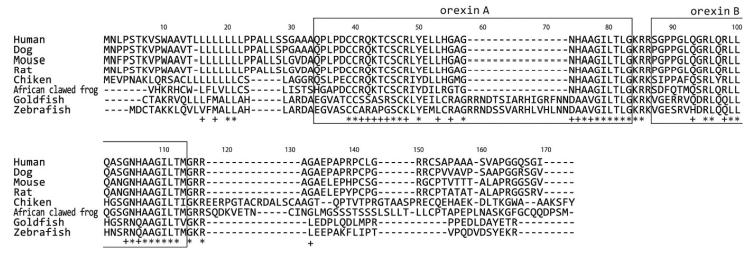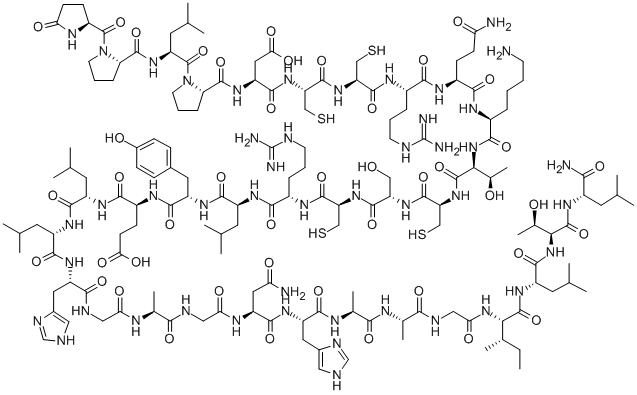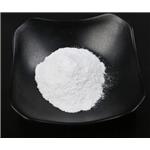Structure
Orexin exists as two molecular forms, orexin-A and
orexin-B, derived from the same 130-aa residue precursor
(prepro-orexin). In mammals, orexin-A is a 33 aa residue
peptide with an N-terminal glutamine cyclized to pyroglutamate, and two intrachain disulfide bonds that are
fully conserved among tetrapods. Orexin-B is a linear
28 aa residue peptide. Orexin-B consists of two α-helices
connected with a short linker. The C-termini of both orexins are amidated. Human orexin-A and orexin-B have
46% homology (13/28), with their C-terminal side in particular being conserved.
Although it was thought originally that orexin has no
functional or structural identity with any other known
regulatory peptide, it is now considered to belong to
the incretin gene family of peptides, including members
of the secretin-glucagon superfamily such as growth
hormone-releasing hormone, pituitary adenylate
cyclase-activating polypeptide, vasoactive intestinal peptide, and glucagon-like peptides. The molecular structures of orexins are relatively well conserved among
vertebrates, especially in the disulfide bond regions in
orexin-A and the C-terminal side in both orexins. Although tetrapod orexin-A comprises 33 aa residues, orexin-A of goldfish and zebrafish is 14 aa residues
longer due to an additional spacer sequence.

Gene, mRNA, and precursor
The human prepro-orexin gene (HCRT), located on
chromosome 17 (17q21), consists of two exons and one
intron. Orexin-A and -B are coded tandemly
in the prepro-orexin mRNA. To date, orexin has been
identified in vertebrates, but orexin-like sequences have
not been identified in invertebrates.

Pathophysiological implications
The dual orexin receptor antagonist suvorexant has
been approved by the US Food and Drug Administration
(FDA) for insomnia. Dual orexin receptor agonists such
as almorexant, lemborexant, filorexant, and SB-649868
have been proceeded clinical trial. Suvorexant and
other dual orexin receptor antagonists are being explored
in a number of other indications, including depression,
anxiety disorders, pain conditions, and degenerative disorders such as Alzheimer’s disease.
Synthesis and release
Orexin-A and orexin-B are synthesized in neurons
located in the lateral hypothalamus. Food restriction
increases orexin mRNA and peptide content in the brain.
In cultured hypothalamic orexin neurons, low glucose
concentration in the medium triggers the synthesis of
orexins.
Receptors
There are two types of orexin receptors: orexin
receptor-1 and -2 (OX1R and OX2R). The orexin receptors
are GPCRs with seven-transmembrane domains. The
amino acid sequence homology of human orexin receptors is mutually 64%. Orexin-A binds to OX1R and
OX2R with a high affinity, whereas orexin-B selectively
binds to OX2R with a similar high affinity. The human
OX1R gene is located on chromosome 1 (1p35), and the
human OX2R gene is located on chromosome 6 (6q11). OX1R and OX2R activate Gq pathways to produce IP3
and an intracellular rise in Ca
2+, or to stimulate the
MAPK pathway. Furthermore, OX2R is able to modulate
the intracellular concentration of cAMP by coupling to Gs
and Gi proteins.
Agonists and Antagonists
[Ala
11, D-Leu
15]-Orexin B and SB-668875 are OX2 specific agonists. Among orexin receptor antagonists, ACT-335827,
SB-334867, and SB-408124 are OX1-specific antagonists;
TCS-OX2-29, EMPA, and JNJ 10397049 are OX2-specific
antagonists; and ACT-078573 (almorexant), MK-4305
(suvorexant), MK-6096 (filorexant), E-2006 (lemborexant), SB-649868, and TCS 1102 are dual antagonists. Further information regarding orexin receptor antagonists
can be found in the review by Lebold and colleagues.
Biological functions
Although orexin was first reported as an appetite-stimulating hormone in mammals, further studies have
revealed its multifunctional status. An important function of orexin is as a regulator of the sleep-wake cycle.
Orexin affects monoaminergic neurons in the locus ceruleus, raphe nucleus, and ventral tegmental area to maintain wakefulness. Orexin systems have roles in regulating
drinking behavior, locomotor activity, and sympathetic
nervous system activation. Orexin contributes to the regulation of the endocrine system, elevating blood corticosterone levels, decreasing blood prolactin levels, and
suppressing the gonadotropin-producing cells in the
hypothalamus. In teleosts, the intracerebroventricular
injection of orexin-A stimulates food consumption and
locomotor activity in goldfish and zebrafish.
Uses
appetite regulation, wakefulness, locomotor activity, hypothalamic-pituitary-adrenal activity, and pain thresholds. Orexin signaling is activated by nutrient depletion, causing an increase in food intake by delaying the signals of satiety. It activates the orexin-1 and -2 receptors with equal affinity.
General Description
Orexin is a hypothalamic neuropeptide consisting of 33 or
28 aa residues. Orexin has a pleiotropic function regulating
feeding behavior, the sleep-wake cycle, metabolism, locomotor activity, and the endocrine system through orexin
receptors. Orexin (also known as hypocretin) was discovered by
reverse pharmacology as an endogenous ligand for two
orphan GPCRs in 1998.
Biological Activity
orexin a, a 33 amino acid hypothalamic neuropeptide, is an endogenous agonist at orexin-1 and -2 receptors[1]. it play a role in appetite regulation, wakefulness, locomotor activity, hypothalamic-pituitary-adrenal activity, and pain thresholds[2].orexin a (10 and 30 mg/kg i.v., 5 min pre-plantar test) increases the latency to thermally stimulated paw contraction to baseline levels. orexin a (3-30 mg/kg; i.v.; 5 min pre-test) significantly increases the reaction latency of intravenous reactions of 10 and 30 mg/kg[3].[1]. rodgers r j, ishii y, halford j c g, et al. orexins and appetite regulation. neuropeptides, 2002, 36(5): 303-325 .[2]. lang m, söll r m, dürrenberger f, et al. structure-activity studies of orexin a and orexin b at the human orexin 1 and orexin 2 receptors led to orexin 2 receptor selective and orexin 1 receptor preferring ligands. journal of medicinal chemistry, 2004, 47(5): 1153-1160.[3]. bingham s, et al. orexin-a, an hypothalamic peptide with analgesic properties. pain, 2001, 92(1-2): 81-90.




